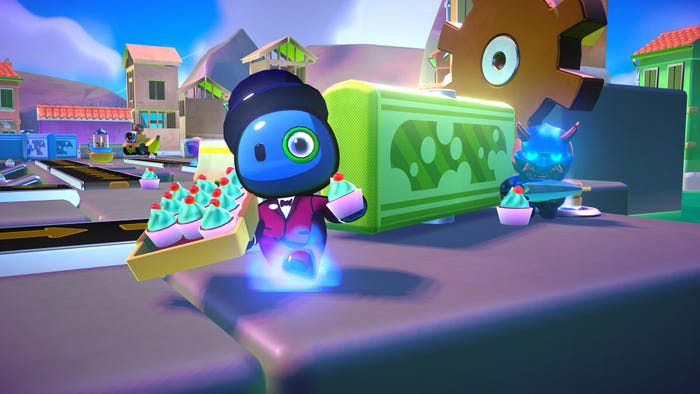William Chyr explains why he went from creating massive balloon sculptures in art galleries to designing infinite virtual structures in his game Manifold Garden.
October 16, 2015

William Chyr began making Manifold Garden, the game previously known as Relativity, because he was developing an allergy for latex.
Chyr was previously known for his tangible artworks that appeared in art galleries, massive sculptures made out of balloons. “The wonderful thing with balloons is that it’s a non-prohibitive medium.” Chyr tells me, with hint of a bittersweet tone in his voice. “I’d just show up with a suitcase and make these massive structures, and they were very liberating to make, as you can fill up a huge space that’s 70 feet across. But I was getting allergic to latex as I was inflating thousands of balloons each time. My throat was starting to constrict, so I decided to stop."
He needed a new medium for his art. He looked at glass and fabric, but they would require structural engineers and a lot of costly shipping. "I still wanted scale, which meant there would be a lot of logistics involved," he says."If I wanted to deal with something other than balloons, I’d have to go down in size.”
Eventually, he rejected the limitations of a physical medium for the infinite medium of games. And when I say infinite that’s exactly what Chyr has created; Manifold Garden is filled with virtual spaces that have no end, each one an architectural construct that wraps around itself recursively, so that there is no point where you bump into the edge of the map.
Step off a ledge, and you can fall forever.
Making reality fold back on itself
This recursive nature of Manifold Garden is something that Chyr is passionate about. At the beginning of our conversation he starts talking about toruses faster than I can keep up with. Eventually, he just laughs and shares his screen with me, so I can see exactly what he means in real time.
 First there’s 2D world wrapping, where that which goes off the right appears on the left, and top appears bottom.
First there’s 2D world wrapping, where that which goes off the right appears on the left, and top appears bottom.
Simple enough.
Then there's 3D, where the interior faces of a cube are reflected.
Okay...
Then, with a bit of a laugh, he twists the model again, so that each interior face of the cube is dissected into four quarters, and they’re reflected so that if something enters the bottom right of a face it appears in the top left of its mirror.
"With art, you make your thing, you have your artist statement, and then your job is done. But a game has to be fun and entertaining."
At that, my brain wrinkles up a little.
“You can do some really crazy stuff when you start inverting faces, and that’s where we’re building the game up to.” Chyr tells me, as if I’m capable of imagining what that might mean.
“What’s wonderful about games is that I haven’t had to compromise on scale, I’ve just gone with infinite size, ” he tells me. “The major issue from a tech standpoint has just been making sure it will actually run. From a design standpoint, it’s relatively simple. The world wrapping mostly just stacks, although we do have some levels where it’s staggered.”
By which he means an offset world wrap, demonstrated on his screen to me by an infinite staircase, reflected above you by another infinite staircase.
Making a mind-bending game inviting for players
I ask Chyr if the infinite nature of the world has proved challenging to players.
“A lot of people find it very daunting," he says. “At first they’re very hesitant to ‘jump’. There’s human nature: Why would you jump? But also in terms of games, falling off something is often a failstate. But in this game, you have to do that. A lot of the puzzles involve you getting across a gap that’s impossible to walk to. So you have to fall to it.”
.gif/?width=700&auto=webp&quality=80&disable=upscale)
It’s here that what Chyr’s doing with Manifold Garden becomes more than just a way for an artist to make endless expanses of sculptures and architecture. The more he talks about the puzzle side of Manifold Garden, the more it’s clear that he’s spent a lot of time thinking about how to make it function well as a game, as well as something of artistic merit.
“The game has gone through a thousand playtesters at this point.” Chyr continues. “Last year, I took it to 14 game events. It’s definitely been...well, not a struggle, but a challenge. With art, you make your thing, you have your artist statement, and then your job as an artist is done. But with designing a game, it has to be fun and entertaining. You have to make sure that everyone wants to get through it.”
Chyr was completely new to game development when he began Manifold Garden two years ago, and has been forced to develop his understanding of game design as he went, especially when it comes to puzzle design and how to present ideas to the player. Despite the brain-breaking nature of the game's architecture, Chyr discovered that he was doing too much hand holding.
“At the beginning, there were a lot of what I called ‘exampuzzles’, and they turned out to not be very fun at all,” He tells me. “Even just me calling them that should be a sign. When I started doing playtesting, everyone said they were really tedious because they knew what they had to do, and they were just applying that learning."
The exampuzzles went out the window. "Now, every single puzzle highlights something interesting, and that’s it," he says. "It’s just focusing on that moment of discovery, and the puzzle isn’t any harder than that.”
How a fine artist approaches puzzle design
The development of Chyr’s understanding hasn’t just been limited to what the puzzles should concern, but also how they should be designed. Citing Starseed Pilgrim, Infinifactory, and Portal, Chyr lays out his design philosophy to me.
.gif/?width=700&auto=webp&quality=80&disable=upscale)
“I think Zach Barth [creator of Infinifactory] called it ‘design based puzzles’, and it’s actually something that I build towards with my game," he says. "Unlike Infinifactory I don’t have numbers that tell you how well you’re performing, or what the global leaderboard is. Instead you’re going to get rewarded by either making a really complex path using lots of the materials available to you, or you might recognize a way to do it much more efficiently, and then you can use the spare materials to do something else that gets you somewhere secret.”
A lot of the ideas Chyr has about world wrapping and how it interacts with puzzle design make me hopeful that it can offer some inspiration to other designers of virtual spaces, as well as challenging our understanding of how a game world can work.
You May Also Like






